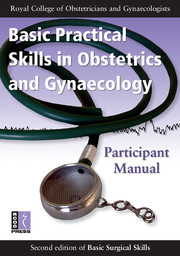Module 3 - Gynaecological procedures, hysteroscopy and laparoscopy
Published online by Cambridge University Press: 05 July 2014
Summary
Basic gynaecological examination and basic procedures
A gynaecological examination is an intimidating experience for most women. It should not be undertaken without prior training using a pelvic model. Having gained experience with the model, vaginal examination skills may be further developed (with consent), on the anaesthetised patient.
Always have a chaperone present when performing any kind of vaginal or pelvic examination. Ensure that the environment is as patient-friendly as possible by performing it in a warm, private and comfortable situation. Allow the patient to undress in privacy.
Most pelvic examinations are performed with the patient in the supine position on an ordinary flat clinic couch. Where procedures are anticipated, such as colposcopic examination, intrauterine contraceptive device (IUCD) insertion or hysteroscopy, it is preferable to use a gynaecology examination couch that facilitates examination in the lithotomy position or with legs supported. Transvaginal ultrasound is also often more informative using lithotomy.
Ensure that the appropriate equipment and instruments are available before approaching the patient; in particular, have a selection of different sizes of speculum to hand. For most nulliparous women, a small Cuscoe speculum is the optimal instrument; for most parous women you will need either a medium or large speculum to access the cervix adequately. When in doubt, it is occasionally worth performing a single-digit examination to assess introital capacity. This also allows the examiner to assess version and flexion of the uterus, which is important for speculum placement.
- Type
- Chapter
- Information
- Basic Practical Skills in Obstetrics and GynaecologyParticipant Manual, pp. 70 - 104Publisher: Cambridge University PressPrint publication year: 2010



